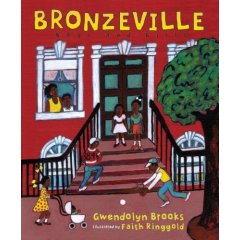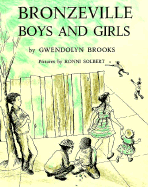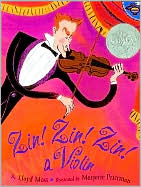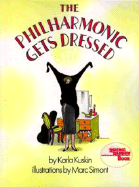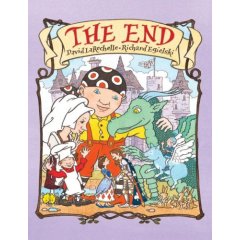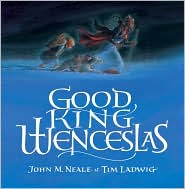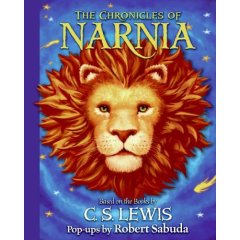The theme for December's Carnival of Children's Literature, hosted by Kelly Herold at Big A little a, is gift books. If you have a little princess on your list (Disney or otherwise, but probably Disney; I hear those princesses are pretty popular), these suggestions are for you--but also for anyone, big or little, who loves fairy tales.
Consider giving a beautifully retold and illustrated edition of a favorite fairy tale.
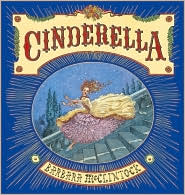 One of our favorites is Cinderella, retold and illustrated by Barbara McClintock from the Charles Perrault version (Scholastic, 2005). McClintock's illustrations (in pen, india ink, and watercolor with gold endpapers) were inspired by a trip to Paris; the prince's palace is based on Versailles and the Paris Opera, and the clothes and hair are from the Louis XIV period. Cinderella's dresses are gorgeous, dripping with flowers or covered in tiny pink ruffles ("The ladies studied her so that they could copy her hair and dress the next day"). McClintock's retelling is as lovely as the illustrations. And there is a little gray cat on almost every page.
One of our favorites is Cinderella, retold and illustrated by Barbara McClintock from the Charles Perrault version (Scholastic, 2005). McClintock's illustrations (in pen, india ink, and watercolor with gold endpapers) were inspired by a trip to Paris; the prince's palace is based on Versailles and the Paris Opera, and the clothes and hair are from the Louis XIV period. Cinderella's dresses are gorgeous, dripping with flowers or covered in tiny pink ruffles ("The ladies studied her so that they could copy her hair and dress the next day"). McClintock's retelling is as lovely as the illustrations. And there is a little gray cat on almost every page.
Look for retellings of the familiar princess stories from other cultures, too.
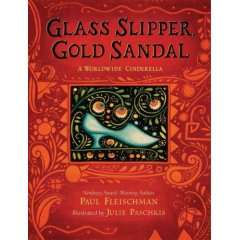
Cinderella again. I think there are more Cinderella stories than any other fairy tale. This year's Glass Slipper, Gold Sandal: A Worldwide Cinderella by Paul Fleischman; illustrated by Julie Paschkis (Henry Holt, 2007) proves my point. Fleischman's text weaves strands of many (17, by SLJ's count) multicultural Cinderellas into one story; Paschkis's illustrations keep them (or rather you) from getting tangled up. I haven't seen this book yet and am curious about how, exactly, it works. The reviews say it does, splendidly. I hope it also includes good source notes, in case I'm compelled to seek out one of the Cinderellas for myself (n.b., I love source notes).
Or introduce a new princess (one who doesn't have a movie contract. Yet).
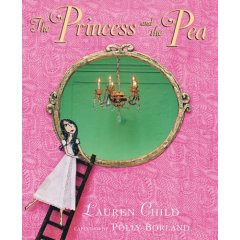 The Princess and the Pea is my favorite of the Hans Christian Andersen fairy tales. This retelling by Lauren Child, captured (photographed) by Polly Borland (Hyperion, 2006) is wonderful: literally full of dollhouse (1/12) scale wonders. A note at the back of the book explains how Child created the sets (out of cornflake boxes!) and drew, cut out, and dressed the characters: it might inspire some small set designers and photographers at your house, too. Child's text, which stays close to Andersen's original, is charming and clever; best of all, it points out that "any real princess has such impeccable manners that it would be impossible for her to tell her host...that it was the most uncomfortable night that she had ever had, in all her life."
The Princess and the Pea is my favorite of the Hans Christian Andersen fairy tales. This retelling by Lauren Child, captured (photographed) by Polly Borland (Hyperion, 2006) is wonderful: literally full of dollhouse (1/12) scale wonders. A note at the back of the book explains how Child created the sets (out of cornflake boxes!) and drew, cut out, and dressed the characters: it might inspire some small set designers and photographers at your house, too. Child's text, which stays close to Andersen's original, is charming and clever; best of all, it points out that "any real princess has such impeccable manners that it would be impossible for her to tell her host...that it was the most uncomfortable night that she had ever had, in all her life."
Finally, a good collection of fairy tales, including those familiar and new, is always welcome.
SurLaLunefairytales.com is an excellent resource for all things fairy tale (and some folklore, too). The work of Heidi Anne Heiner, SurLaLune features 47 (and counting) annotated fairy tales. Especially helpful in the context of this post (what was that again? oh yes, gift books for princesses and people who love fairy tales!) are the picture book galleries for each fairy tale (here's Cinderella's). Which are your favorites?





